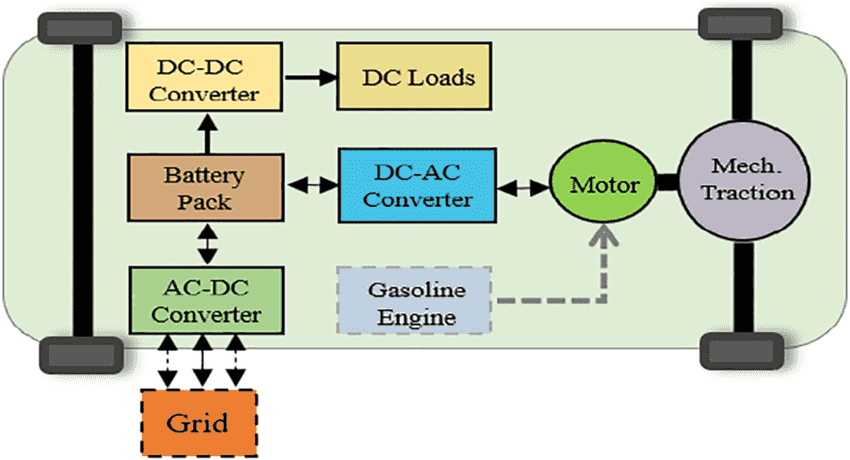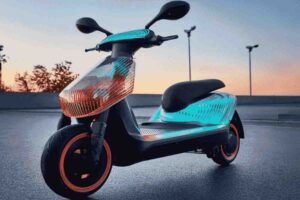Introduction
An EV powertrain is the combination of various components of an electric vehicle that basically work together to convert the electrical energy into mechanical energy to make the vehicle move. Additionally, electric vehicle batteries provide energy to it.
Due to the absence of internal combustion engines. Certainly, the EV powertrain has less weight and a compact system. As a result, the system produces minimal vibration and generates instant torque. Hence these elements combined deliver high quality and smooth drive.
The electric motor, power electronics, and batteries comprise the EV powertrain in general. Even it comes with different types of technologies too!
In this blog, I will be providing a general and detailed overview of EV powertrain architecture, and many more.
Table of Contents
ToggleHow EV powertrain different from an ICE Powertrain

ICE Powertrain
The primary source of energy comes from the combustion of fuels.
ICE powertrains are composed of multi-speed gear box+ Differential.
In contrast to electric vehicle powertrain, ICE has many moving which are consistently exposed to high temperatures and friction. Hence, we require regular oil changes and high maintenance.
Most of the energy is converted into heat and friction loss in the ICE powertrain. hence, Provide lower efficiency of 20-30%.
Indirect conversion of energy. Because chemical energy (fuel) to thermal energy to mechanical energy.
ICE powertrain typically offers higher power output and top speed, but torque delivery will be lesser than the EV powertrain.
EV Powertrain
The source of energy in the EV powertrain comes from the battery or fuel cell.
Furthermore, the gearbox has a single-speed gearbox+ Differential.
An EV powertrain has very few moving parts compared to an ICE powertrain. hence required less maintenance.
Since, due to fewer moving parts, Mechanical energy isn’t converted into other forms like heat. So, it typically has a higher efficiency of 80-90%.
Direct conversion of energy is electrical to mechanical energy.
It also offers instance torque, smooth acceleration, and quieter operation. But lacks in power and top speed.
EV Powertrain Architecture and EV Powertrain Block Diagram

Surprisingly, the EV powertrain components have more than 50% fewer than ICE powertrain components. This makes electric vehicle powertrain architecture simple and compact.
The EV powertrain components or EV powertrain architecture include an electric motor, battery pack, inverter, charger, DC-AC converter, DC-DC converter, etc.
Electric Motor | EV Powertrain
This electric motor converts the electrical energy to mechanical energy. Moreover, the electromagnetic fields provide torque, and the battery supplies the energy.
As discussed earlier, the electric motor is capable of giving more than 90% efficiency.
Battery Pack
The battery pack is an important component in the EV powertrain. Further, it costs 1/3 rd. of the cost of the entire system. An expensive component in the system is considered to be a battery pack.
The battery pack acts as an energy-storing device. It provides output in DC-direct current.
DC-AC Converter
The DC-AC converter converts the DC output of the battery to AC. The Powertrain Electronic Control Unit controls these power transfers.
In addition, the Powertrain Electronic Control Unit adjusts the frequency and magnitude of voltage supplied to the electric motor. Hence manage the speed and acceleration as per the driver’s instructions through the accelerator or brakes.
DC-DC Converter
Unfortunately, the battery pack only delivers a fixed voltage, but the voltage requirement of different accessories like lights, wipers, displays, etc. Would vary.
With this in mind, a DC-DC converter is made to distribute voltage power to different systems by converting the output power from the battery pack to the required level.
Thermal Management System
The Thermal Management System is made to maintain optimal temperature and extend the lifespan of the battery.
This is particularly important for maintaining efficiency and safety. Because extremely high temperatures often increase the chance of battery explosion. Especially for lithium-ion batteries.
Battery Management System (BMS)
The BMS is made to monitor and control the state of the battery to detect any anomalies. Following, it calculates the remaining battery capacity to provide accurate range information.
BMS indeed ensures that all cells in the battery have a similar state of charge to prevent undercharging or overcharging, which can lead to performance issues and safety hazards.
Furthermore, communicates with other vehicle systems, such as the motor controller and charging system, to optimize energy management.
Onboard Charger
The onboard charger controls the current flowing into the battery by adjusting the DC output voltage. Further rectifies the AC voltage to DC voltage.
What are the Types of EV Powertrain

Electric vehicle powertrains are categorized into various types based on energy source and propulsion system.
- Battery Electric Vehicle (BEV)
- Plug-in Hybrid Electric Vehicle (PHEV)
- Hybrid Electric Vehicle (HEV)
- Extended-Range Electric Vehicle (EREV)
- Fuel Cell Electric Vehicle (FCEV)
We have discussed more details related to types of EV powertrain in a recent post. Kindly refer to it by following this LINK.
EV Powertrain Trends and Future Developments

Based on a report published. At this instant, we can expect more than 60% of new vehicle manufacturers will be BEV or EVs by 2030.
Additionally, the EV powertrain is rapidly evolving. The key trends are the advancement of battery technology for a longer range and fast charging with solid-state batteries.
Huge efforts are made to replace expensive materials with low-cost materials and more readily available materials.
Overall, the powertrain manufacturers working towards electric vehicle powertrain development by integrating components or modules. Due to this, the electric vehicle contains fewer parts overall, making it lesser in weight and more sustainable.
Hence, in conclusion, the future holds the integration of components, modular platforms for flexibility, vehicle-to-grid technologies, and AI-driven optimization.
Despite challenges like high battery cost and infrastructure, I hope the electric vehicle powertrain market will be immense with opportunities for innovation and growth.
Conclusion
hope, you have got a good insight into the Electric vehicle powertrain, EV powertrain components, etc. through this blog.
As the world transitions towards a sustainable future, EV powertrains are at the forefront of this revolution, promising cleaner air, reduced dependence on fossil fuels, and a quieter, more efficient driving experience.
FAQs
How efficient are EV powertrains?
EVs convert over 77% of the electrical energy from the grid to power the wheels.
What is the function of the electric powertrain?
The e-Powertrain powers our EVs and removes the need for an internal combustion engine
What are the basics of EV powertrain?
EV powertrain converts the battery’s stored electrical energy into mechanical power to propel the vehicle.
What are the 4 types of powertrain systems?
There are four types of drivetrains: front-wheel drive, rear-wheel drive, all-wheel drive and four-wheel drive
What are powertrain operations?
The electric powertrain is the electric drive system that powers electric vehicles
What is the difference between drivetrain and powertrain EV?
The drivetrain provides power to the wheels and the powertrain consists of both the motor and the drivetrain.



![Read more about the article GMC Hummer EV SUV [2024] – Price, Features, Design…](https://evelectrichub.com/wp-content/uploads/2024/08/GMC-Hummer-EV-SUV-Featured-Image-300x200.jpg)

